Do I Need Trekking Poles?
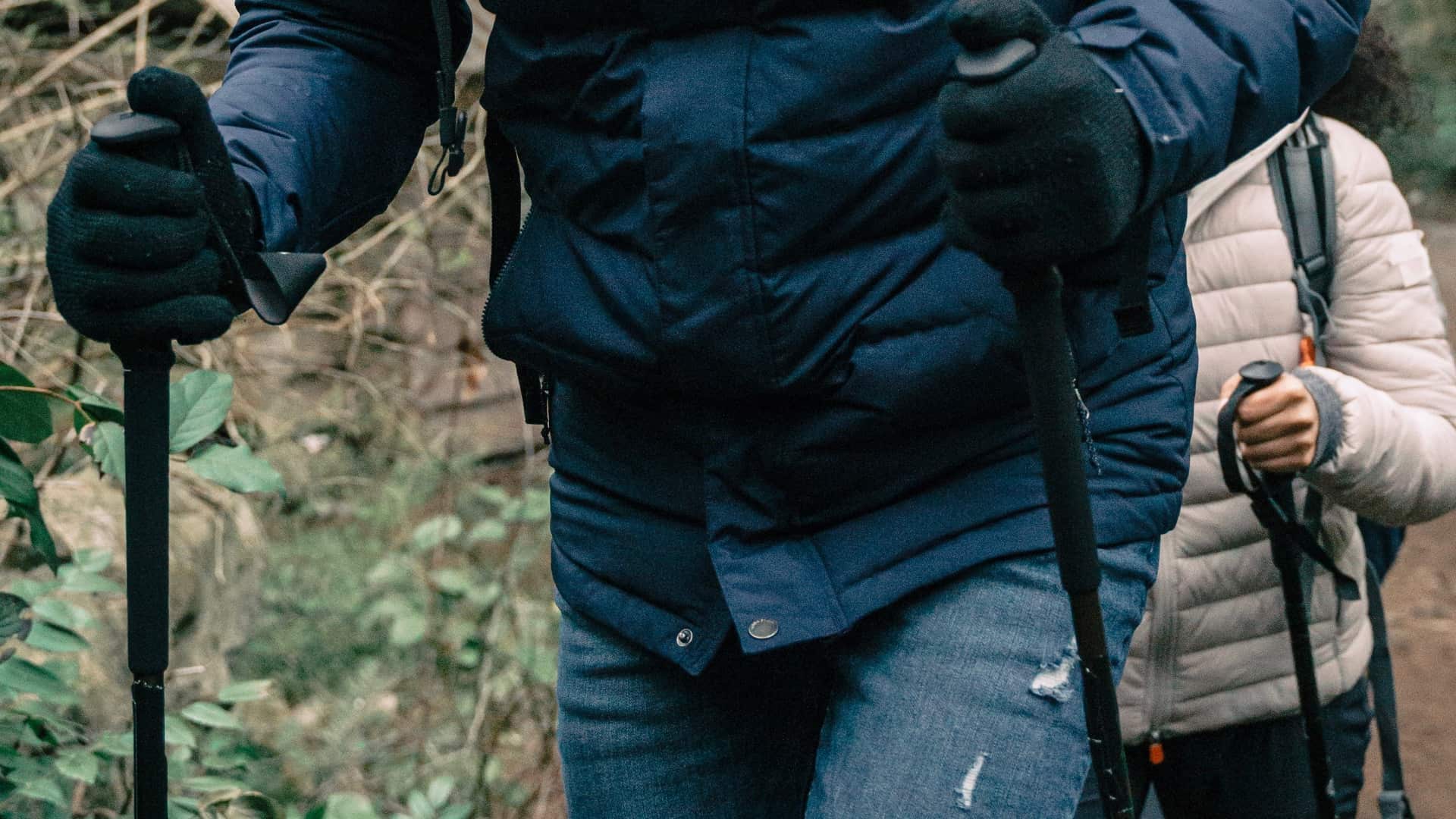
Trekking poles are standard equipment for many experienced hikers – but do you really need them? The answer is maybe—there are a few conditions that I use hiking poles under and some I do not. Here’s how you should determine whether you need trekking poles or not.
A trekking pole (also known as a hiking pole) is basically a ski pole with a handle that you use when hiking. Trekking poles are almost always used in pairs. There is also something called a hiking staff (also known as a hiking stick) that is a single pole. Most hikers go with two trekking poles over a hiking staff. I think the pair just provides more benefits.
After years of using trekking poles, this is what I’ve learned about using them (and not using them).
Why Use Trekking Poles?
- I use hiking poles when I have a heavier backpack on. There’s no getting around that when you have some serious weight on your back, hiking poles can help keep you stable, especially on a steep incline or decline. Do they take strain off my knees? Not really, but more on that later.

- If your hike requires stream crossings, trekking poles are great. Having two poles to anchor your way across a series of slippery rocks is invaluable. Even if I’m not using trekking poles on my hike, I’ll usually carry them in my pack just for this reason. Similarly, if I need to test the depth of a stream or see how muddy the bottom is, trekking poles get the job done.
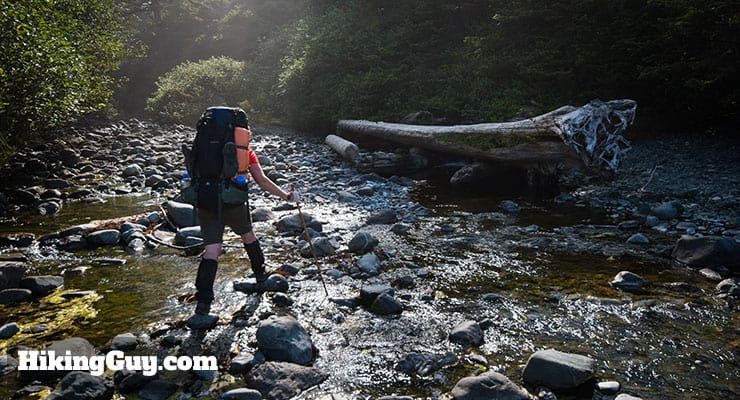
- If you are hiking in winter conditions, trekking poles are great for balance on a slippery and snowy trail. And when you’re crossing a frozen stream, using the trekking pole to test the ice is a great option.
- Trekking poles are good to have in bear and mountain lion country. I’ve never actually fought off an animal, but I’ve often thought that if I was attacked, having trekking poles ready in hand would be better than not having them.
- If you hike in an area with poison ivy, poison oak, nettles, or any other plant you want to avoid, trekking poles provide an easy way to gently push them to side and hike by.
- If you have a steep downhill, trekking poles can provide good anchor points to balance against as you hike down.
- Likewise, if you’re on a steep upslope, you can use poles to dig in and pull yourself up on.
- If you want to make your hike more of a full body workout, there’s no denying that moving your arms back and forth will help you expend a little more energy. It’s also nice to get in a rhythm with hiking sticks.
- If your hands swell when hiking, using trekking poles will keep the hands closer to the level of the heart, improving blood return to your heart.
- You can use trekking poles as supports for an ultralight shelter. This will save you some weight in your pack. Even if you’re just day hiking, having a ultralight shelter in your pack (and hiking poles to support it) is a great way to be prepared for a survival emergency
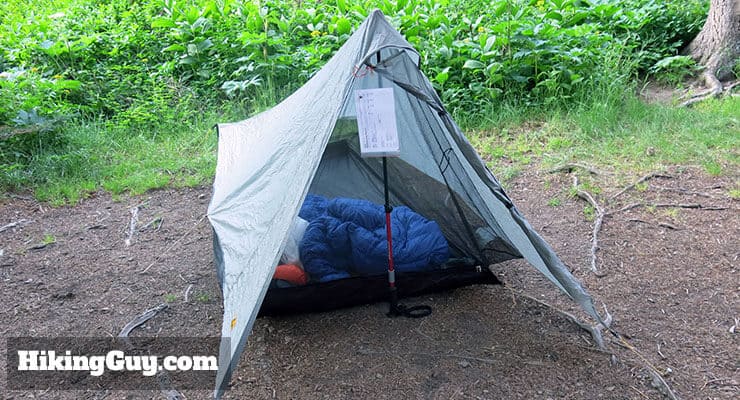
Do Hiking Poles Really Save Your Knees?

Many articles quote a 1999 study that says using trekking poles takes up to 25% of the strain off of your knees. The reality for most hikers isn’t that great. In fact, there studies that show that there’s no difference whatsoever between shock absorbing poles, regular poles, and no poles.
Personally, I’ve had knee pain with and without poles. I stopped my knee pain completely by simply shifting my weight. Instead of heel striking, I now focus on stepping on my fore and mid-foot. This engages the “natural shock absorbers” of my hamstrings to buffer any shock in my step. I think hiking with trekking poles naturally allows people to shift their weight (and foot strike) forward, which is probably a factor in those reduced strain studies. So if you want to help your knees out, I recommend shifting your weight forward when hiking with trekking poles.
When Not to Use Trekking Poles
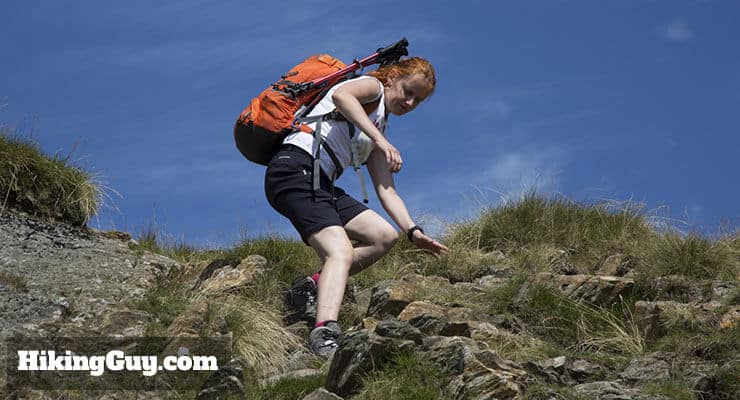
I used trekking poles religiously for years. And then I stopped for a while and it felt great to “just walk” without another piece of gear. Here’s why I stopped.
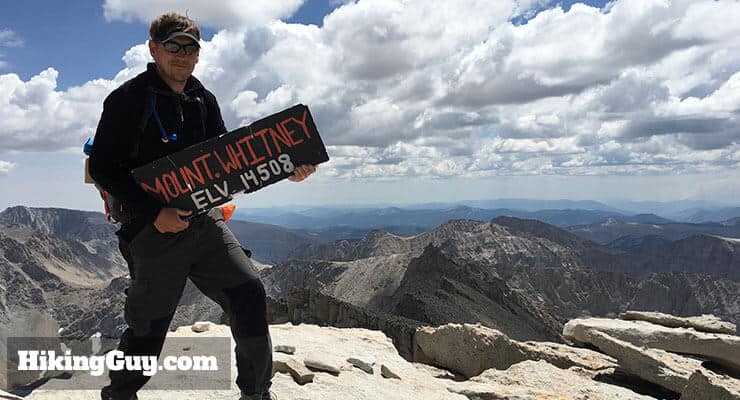
- I was hiking to connect with nature, and the poles started to seem like a barrier between myself and the earth. So instead of using a pole to balance when descending, I now reach out and touch trees, rocks, and dirt. It just feels better.scramble down. You’ll feel like a kid again.
- Ditching the hiking poles was one less thing to deal with. I put my boots and pack on, then hike. Easy.
- I realized that using poles was not good for my balance and core. When I don’t have trekking poles, I need to stick my arms out and shift my weight to balance. This engages my core and natural balance processes instead of turning them off.
- On longer hikes, not swinging my arms when I walk saves me energy. It’s not a big deal for shorter hikes, but if you’re doing something like a 22 mile Mt Whitney day hike, having another 1-5% of energy in your tank is a big deal.
So Should I Get Hiking Poles?
Some people absolutely love hiking with trekking poles all the time. I used to be that person. But now I mix it up depending on the circumstance. My backpack allows me to attach my trekking poles to the outside. So if I feel like using them, I just take them off and extend them. It takes 2 minutes.
Trekking Pole Recommendations
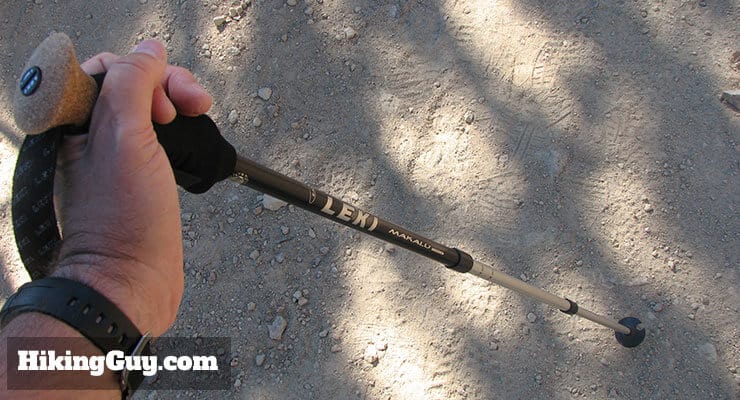
Trekking poles have some features you should look for. These are my recommendations:
- Carbon fiber and aluminum are both really light and work well. If you’re going to bang them up a lot, go with aluminum. Carbon offers a little more shock dampening, but can shatter if you really smash them around.
- Shock absorbers aren’t really necessary, but if you find a pair you like and they have absorbers, go for it.
- Get hiking sticks with cork or foam grips. Don’t get poles with hard plastic grips, they generally suck.
- When you use hiking poles, you want your elbow to be at about 90 degrees. Most trekking poles are adjustable so you can easily adjust the size. If not, REI will have a sizing chart based on your height. The type of locking mechanism on adjustable trekking poles isn’t super important. Some people recommend adjusting the height up or down based on the slope, but I’ve never met anyone who actually took the time to do this.
- Don’t worry about baskets or pole tips. As long as you have steel tips, you’ll be fine.
- Learn how to use your straps correctly.
Have questions or need trip planning help? Join me on Patreon for direct access—ask me questions, get custom trip advice, and enjoy exclusive behind-the-scenes content. Create a free Patreon account to get my Monthly Newseltter sharing important hiking and outdoor news, as well as new guides.
| Related Guides |
|---|
| Hiking Boots or Shoes: Do I Really Need Hiking Boots? – The great dilemma – do you really need hiking boots? Or can you use hiking shoes? Or do you even need hiking shoes? This guide will sort it all out for you, but the short answer is that you probably don’t need hiking boots. Hiking shoes or trail runners will be a better bet for most hikers. |
| The Modern Hiking Essentials – The ten essentials are the ten pieces of gear that every hiker should bring out when them on the trail, whether on a short hike or multi-month through hike. The ten essentials were invented in the 1930s to help people enjoy the outdoors safely. It was an era before helicopter evacuations and satellite beacons; the ten essentials were designed to help folks stay alive outside. Today the ten essentials still hold true at their core, but can be improved upon with the help of new gear and technology. Here’s my take on the hiking essentials; this is what I take on every hike and what you should too. |
| More How to Hike |
Latest Hiking News

National Park Update

Latest Hiking News

East Coast Trip Update
Join Me on Patreon for Free
Latest YouTube Videos

2025 Gear Updates

Rim to Rim Fire Update

inReach Mini 2: 3 Years Later

Starlink for Hiking
Written by Cris Hazzard
Cris Hazzard, widely known as “Hiking Guy”, is a professional hiking guide, outdoor expert, and author with over 25 years of experience. Based in Southern California, Cris is dedicated to helping hikers of all skill levels explore the outdoors safely and confidently. His detailed trail guides, gear reviews, and outdoor tips have been featured in major media outlets, including CNN, FOX, NPR, the Guardian, and the Washington Post. A trusted voice in the hiking community, Cris shares his expertise through his website and YouTube channel, offering practical advice and inspiration for outdoor enthusiasts worldwide.
Read This Before Hiking With These Guides
The information on HikingGuy.com is provided as a public service to assist individuals in enjoying the outdoors. While every effort is made to ensure the accuracy of the content, HikingGuy.com makes no warranties or representations regarding its completeness, reliability, or suitability for any purpose. This website is not a substitute for official sources of information and should not be relied upon as error-free or as the sole basis for decision-making. Use of this information is entirely voluntary and at the user’s own risk. HikingGuy.com disclaims all responsibility and liability for any loss, injury, or damages resulting from the use or misuse of this information.
Affiliate Notice
Some links on this website to REI, Amazon, and other products or services are affiliate links. This means that if you click on a link and purchase an item, I may receive a small commission at no additional cost to you. However, I only recommend products or services that I personally use and believe will benefit my readers. This disclosure is in accordance with the Federal Trade Commission’s 16 CFR, Part 255: Guides Concerning the Use of Endorsements and Testimonials in Advertising.
The 10 Best Splitboard Poles for Splitboarding
We became snowboarders so we wouldn’t have to mess around with poles and stuff. Then we became splitboarders so we wouldn’t have to mess around with crowds and poles became even more important. They’re how we get up hill, sure, but when we come back down your poles need to shrink and be light enough to carry on your back.
Another reason poles are so clutch for us: sometimes you need just a little push so you might be poling your board for a couple hundred. When that goes down, the strength of your poles is absolutely paramount. So they’re necessities for heading uphills, need to disappear when going down, and need to be strong enough to push you forward by arms alone. No easy feat but lucky for you, we compiled our list of the best of the best.
Best Splitboard Poles We Tested
Contents hide
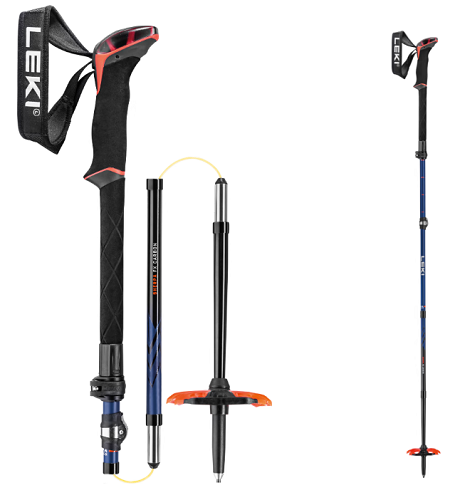
LEKI Sherpa FX Carbon Poles
When you want top of class, the LEKI Sherpa FX Carbon is tough to beat. We’re talking aluminum HTS and carbon PRC for the body. We’re talking the super ergonomic Aergon Air handles, comfortable on long tours and made even extra comfortable with the extra-long grip extension.

The ELD device on the poles makes it easy to fold up but gives a great feeling of security when it’s locked tight. I love how adjustable it is thanks to the speed lock 2 plus so you can adjust height from 110 to 130 cm. The neoprene strap is also pretty chill.
Basically, when you’re looking for the absolute best pole, comfortable for long tours, you need the LEKI Sherpa FX Carbon pole.


Amazon US


LEKI
Last updated: 2025-08-02 21:06:58
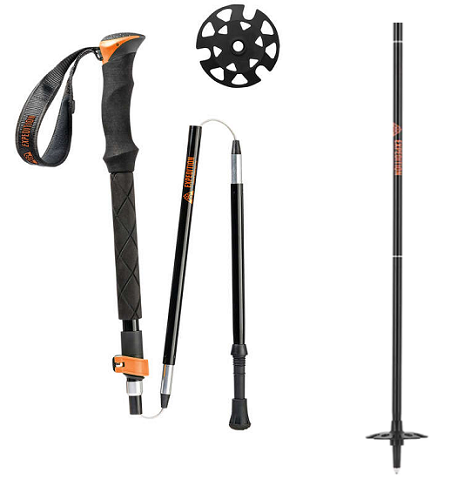
Union Aluminum Touring Poles
A few years back Union, long a leader in the binding world, threw their hat into the ski touring game. Their splitboard bindings have long been at the top of our best of list. Now they have their own Union Aluminum Touring Poles. These are basic and perfect. Their fastlock system makes for quick folding to throw in your pack for that epic down (possibly on Union bindings).

They collapse from 135 cm to 41 cm. You can adjust the length when poling up and the extended grip pulls from all the other long grips we’ve grown to love. Plus it’s a splitboard gear company so you know you’re supporting one of our people. In some ways these barebones, well-built board gear company poles are the most dedicated to splitboarding you can get.
Sorry, no prices available at this time.
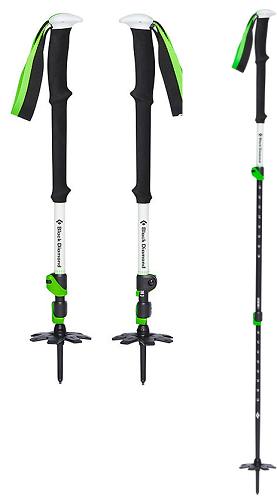
Black Diamond Expedition 3 Poles
If you’ve been splitboarding since back in the day, you definitely owned a pair of Black Diamond Expedition poles. And if you’re new to the game, trust us OGs and pick up a pair of the most trusted pole standard.

The Expedition 3 is a simple telescoping touring pole with two FlickLocks. It’s 3 parts of aluminum. It’s dependable. It’s time-tested. It collapses to 22.2 inches (or 24.2 inches for the bigger one) and expands to 48.8 inches (or 54.6). If you want the pole that’s reached a couple million peaks, the Black Diamond Expedition 3 is your perfect touring pole.
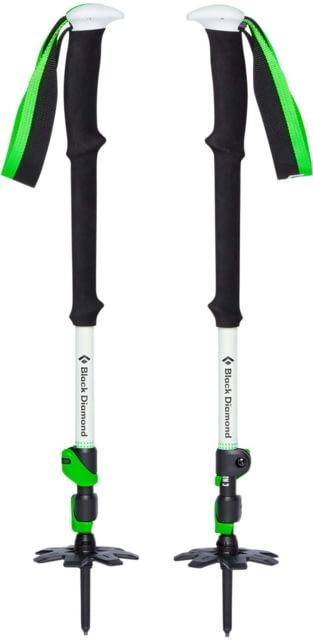

CampSaver.com

Scheels
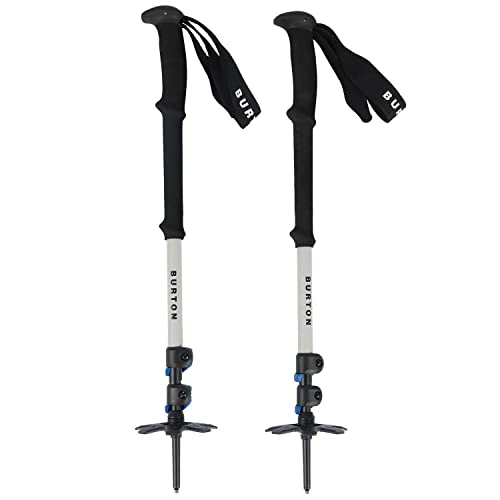

Amazon US
Last updated: 2025-08-02 21:07:00

BCA Scepter 4S Poles
BCA has done so much in the backcountry, you could almost overlook their bomber Scepter 4S poles. Almost, but you’d be making a mistake there. To start off, there’s the strong aluminum structure for their folding 3-part poles. Those folds take it from 130 cm to 43 cm for the descent. But the real magic is in the grips.
Yeah, they have an EVA grip and a choke-up sleeve. The handle ends in the Scraper Grip, a real game-changer. The snow that builds on your split, especially when the snow starts getting warm and heavy, adds up quick. This scraper is made to scrape the snow off the topsheet and off your splitboarding skins. Yeah, it also has a tungsten tip and that BCA reliability. But given it’s spring, that scraper grip is key.
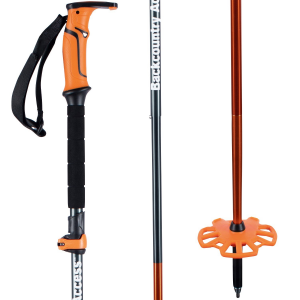

evo


Amazon US
Last updated: 2025-08-02 21:07:01
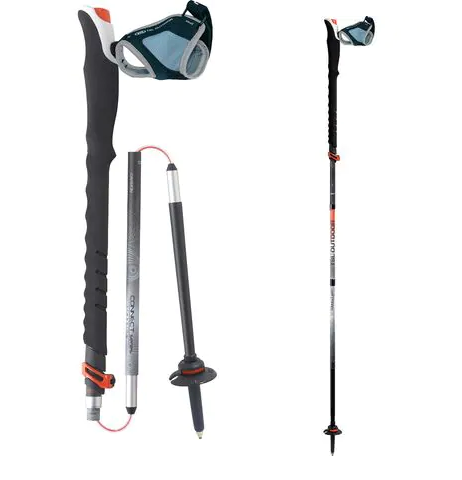
TSL Outdoors Connect Carbon 5 Poles
TSL’s Outdoors Connect Carbon 5 poles fold down to 16.5” inches from 51.2”. This is a pole made and perfected in the French Alps, home of ski touring (try to tell the late Doug Coombs otherwise). It’s got a burly folding form with a pretty cool push button design. But there’s also the pole adjustments, allowing you to from 43.3 to 51.2 inches.
They’ve got tungsten tips to penetrate anything. Two basket sets with their patented Push and Pull system for easy replacement. And the EVA handle is like the length of your forearm, making all your micro-adjustments during touring super easy and comfortable. Yeah, this is a features-heavy magical pole with great design and a small pack size. Perfect for all your big days.
Sorry, no prices available at this time.
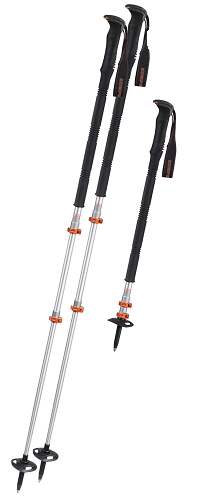
Komperdell Titanal EXP Pro Poles
Komperdell again, this time with their Titanal EXP Pro poles. These are poles made for that splitboarder who’s really tough on their gear, and then spends the summer traversing high alpine snow. The shaft is made of burly 7075-T6 aluminum.
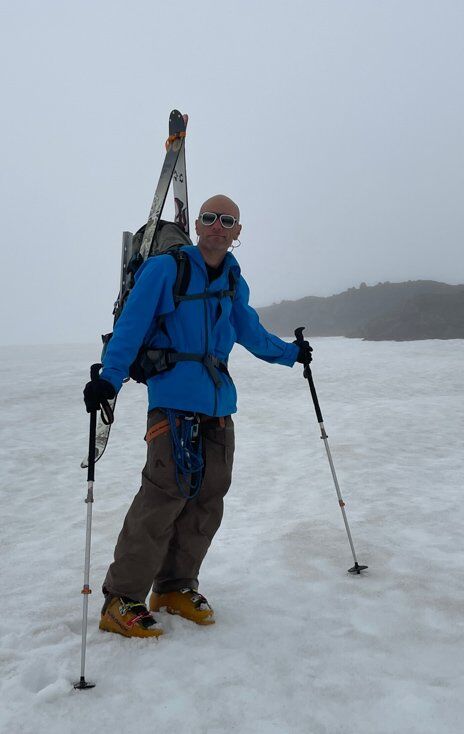
The grip is long, soft, fits your hand, and when you flip the pole over can be used to adjust your risers. It’s got carbide tips for snow, ice, even stone. Even more, the large snowflake baskets keep them floating on top of the deepest snow. The telescoping design is strong enough to handle the heaviest weight on the roughest terrain but still allows a 140 cm pole to shrink to 65 cm. Sure, they’re over a pound. But they can handle literally any and everything that could come your own savage way, for a long, long time.


Amazon US
Last updated: 2025-08-02 21:07:03
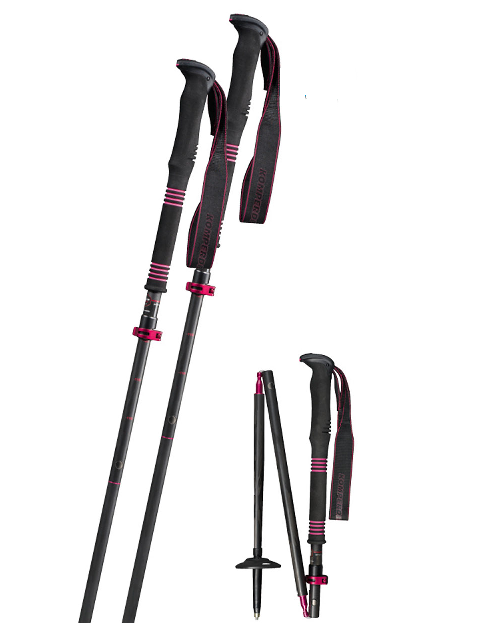
Komperdell Carbon FXP4 Expedition Poles
Komperdell’s Carbon FXP.4 are all-time bomber, which makes sense since they’re made by a company that’s been making poles since before your grandfather. The extended Trek pro 240 grip lets you transfer all your strength into the poles. Which the carbonal rocksleeve and titanal lower handles with aplomb. Especially for a set of poles weighing about half a pound.

The ice flex basket is especially cool – it adapts up to 28 degrees for the slope’s incline. What we really love, though, is the self-deploying foldability of the poles which, combined with the Powerlock 3.0, means the Carbon FXP.4 Expedition can pack down super small. Though the wickets mean these can also double as trekking poles when peak bagging is done on foot instead of on split.


Amazon US
Last updated: 2025-08-02 21:07:04

LEKI Bernina Lite 2 Poles
Is there anything cooler than a cork handle? LEKI’s Bernina Lite 3 knows the answer is no. That’s why they topped their Lite 3 poles with a Thermo Foam with a cork look, for the perfect blend of style and performance. The Aergon Air design is made for smaller hands because this is a pole made specifically for women.
The HTS gives you dependable strength on all tours. It also incorporates the Speed Lock 2 plus LEKI loves so much with a weight just over 9 ounces. It also has the large binding basket favored by LEKI’s poles made specifically for binding adjustments on the fly – rising and dropping your heel while touring. Because your size doesn’t matter when you’re looking to go big.


Amazon US


LEKI
Last updated: 2025-08-02 21:07:05
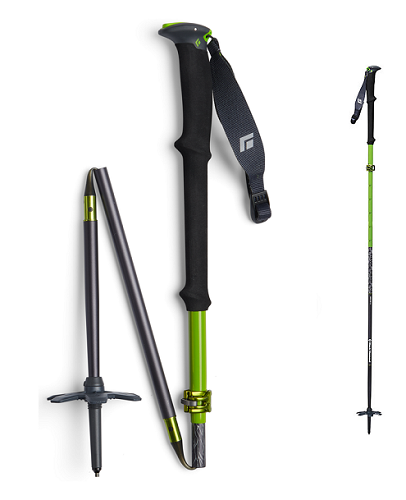
Black Diamond John J Compactor Poles
We love gear with multiple uses, talk about it all the time, and Black Diamond must have been listening to us when they came out with the John J Compactor pole. John Jackson helped design this, a real snowboarder’s snowboarder. Black Diamond was one of the first companies I saw using this Z-Pole design and they bring it here. Then the nice long handle. Oh, but what a handle it is.
We were talking about how nice it would be to have a multitool that could chip ice off your bindings. The John J Compactor has a multitool in the handle. The removable WR Expedition foam grip can be removed from the poles and they hide compartments that can hold your drivers. And of course you can throw on a whippet or whatever cool backcountry tools you’ll need. Some of the best collapsible backcountry ski poles on the market.


Amazon US
Last updated: 2025-08-02 21:07:07

G3 Pivot Poles
G3 of course stands for Genuine Guide Gear, and their Pivot poles are just that: splitboard touring poles made to handle the rowdiest conditions people who live in the backcountry might throw at them. The ergonomic handles lock into your fingers with foam up and down from the top of the grip so you can adjust your fingers up and down.
Since they’re split poles they fold up super small, wrapping around the handle with magnets to hold them in place. Their aluminum construction deliver dependable strength but weigh in at little over 10 ounces per pole. Plus they have two options meaning they can work for people from 4’9” to 6’6”. A perfect splitter pole.


Gravity Coalition


Amazon US
https://hikingguy.com/how-to-hike/do-i-need-trekking-poles/https://mtnweekly.com/reviews/splitboard-poles/splitboarding-poles/
